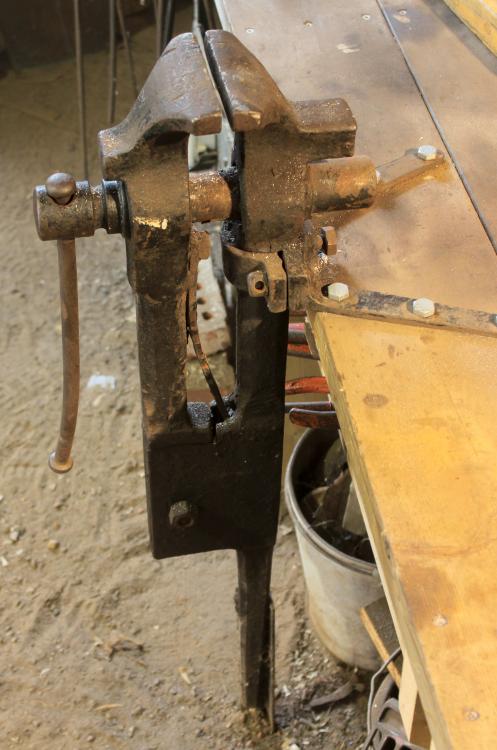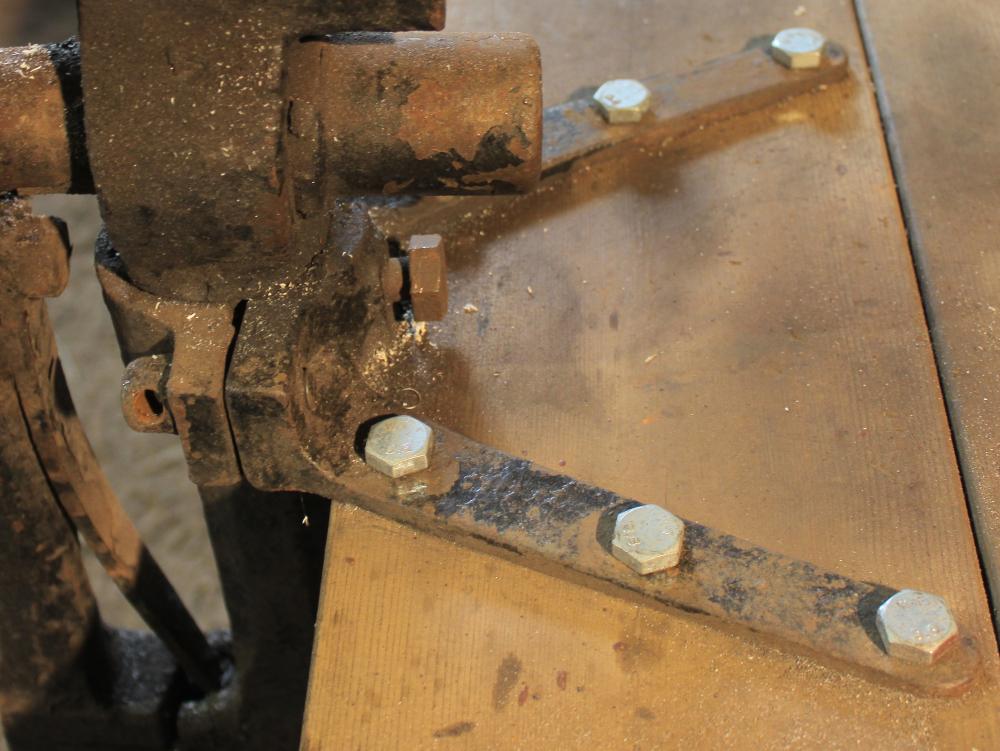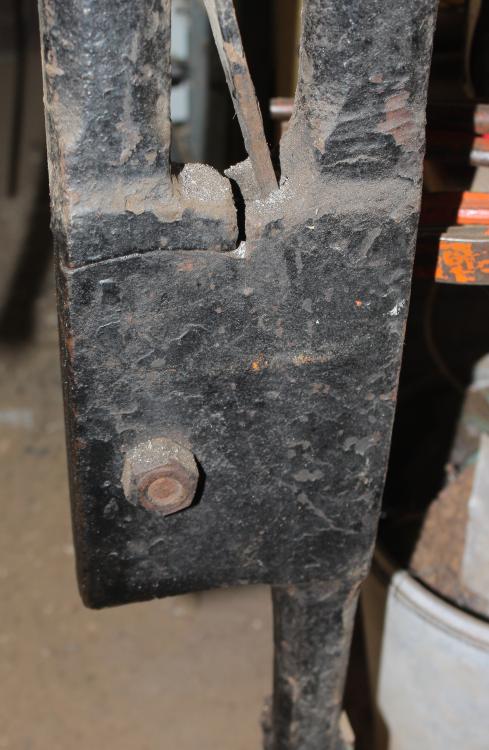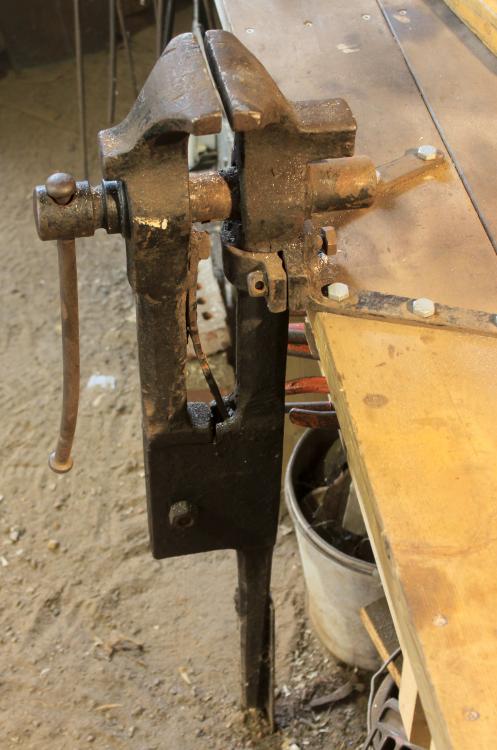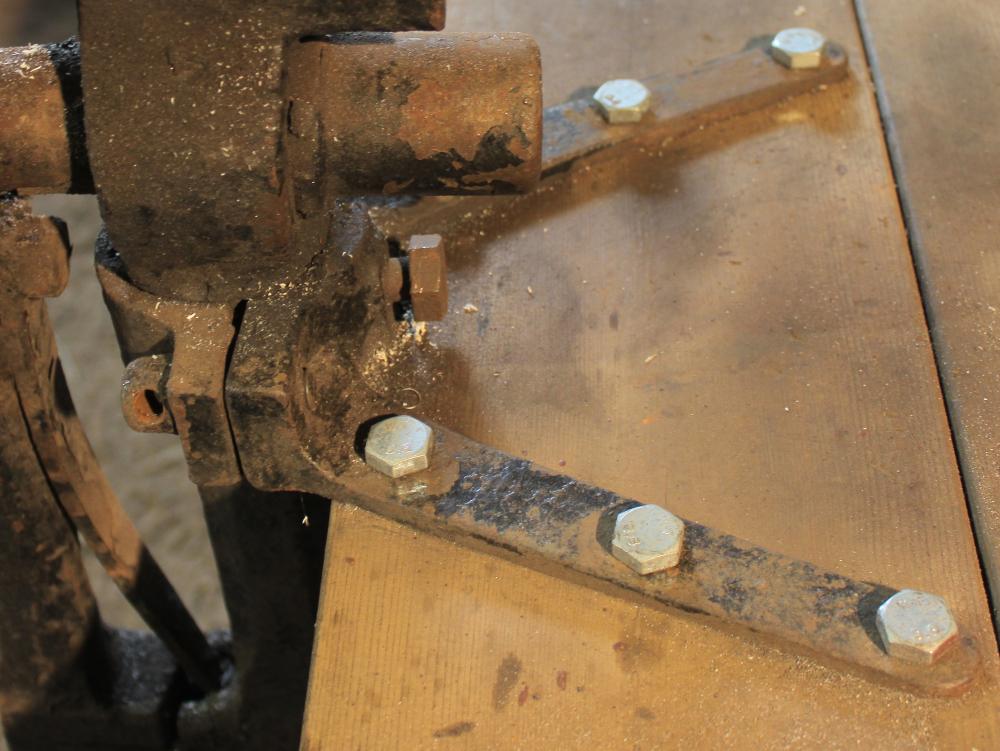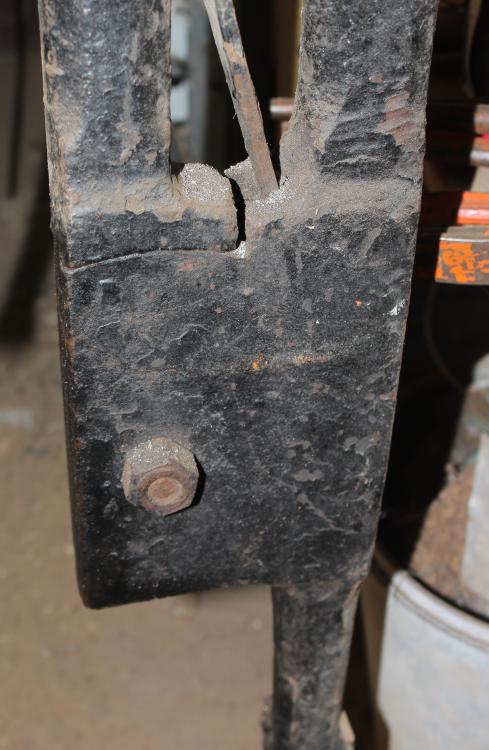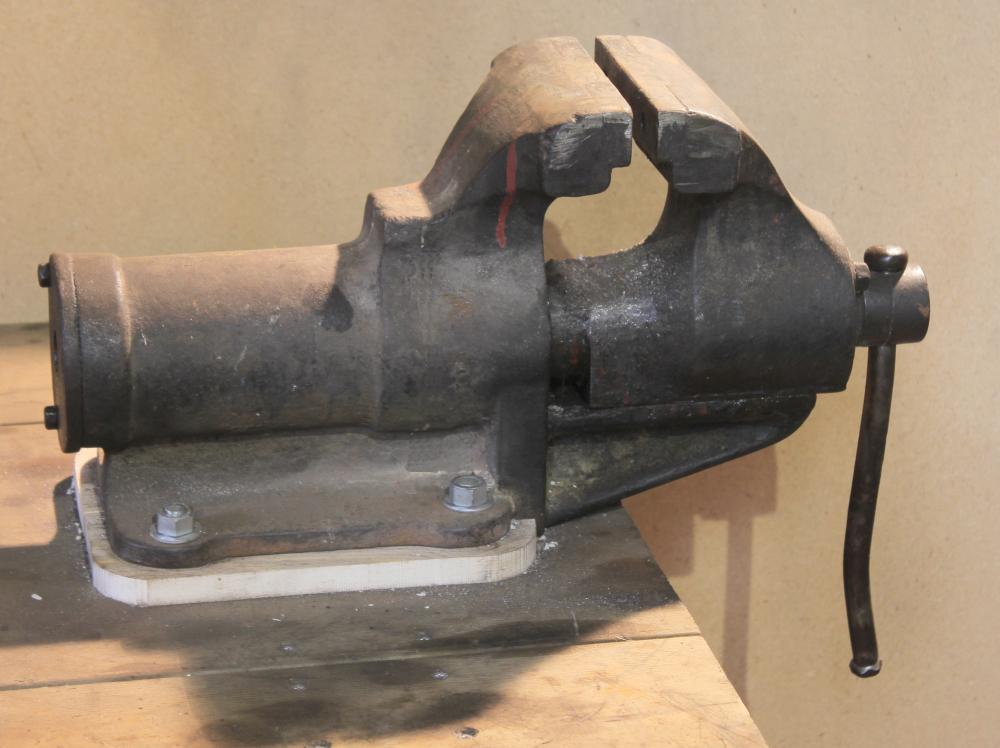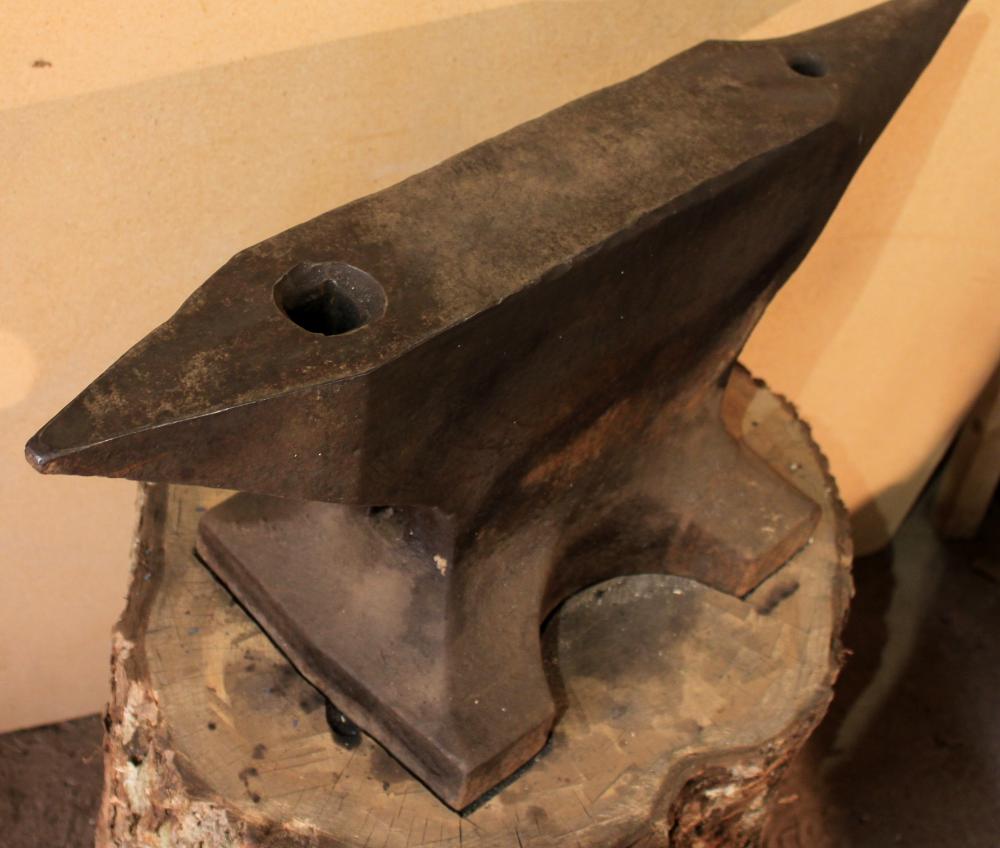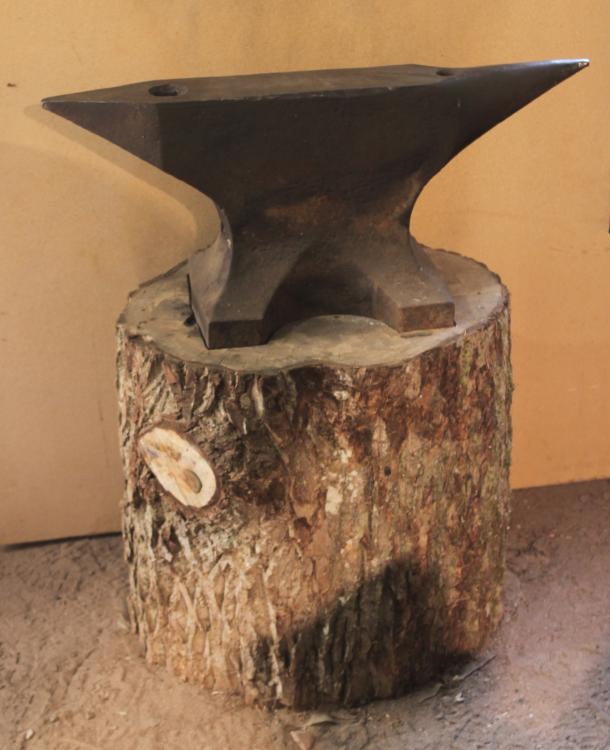
gote
Members-
Posts
779 -
Joined
-
Last visited
Content Type
Profiles
Forums
Articles
Gallery
Downloads
Events
Everything posted by gote
-
I think you are umderestimating ds99. If the guy says his welder does not work it is not impossible that his welder does not work. He asks what should he do instead. I would try to drill holes at the ends of the billet and rivet. I would also try to use a longish bar, preferably of one of the materials in the billet, and include that in the riveting, Even nuts and bolts may work. Göte
-
I never look into the brightest parts of the fire beause it is uncomfortable and that is nature's way of telling me "Don't do it!" Besides, I always keep my fire "black". Meaning that I always keep the glow covered by coal/charcoal that is not actively burning. If I am not using too much blast, the fire is confined below the black layer. If I need to look at the steel I pull it out and then back or scrape the layer away very briefly and then back again. I may be wrong but I believe that I limit heat loss by radiation and that this is a good thing not so much because of fuel saving as because the steel heats up better. I notice that I sometimes have blue flames above the fire which I attribute to burning carbonmonoxide. Carbonmonoxide not only prevents scaling, it even to some extent gives off carbon to the steel even if the amount is negligible in a normal forge. I use a Swedish "field forge" field meaning used by cavalry farriers when out near the battle field. It is an approximately 2'x2' steel plate with a cast iron pot in the middle and blowing through an easily adjustable valve from below. Comments would be welcome Göte
-
This particular vise was own by a plumber in the 30-ies. He would never have had any trucks in his shop and the vise is too heavy to move around from site to site and besides it is not the typical plumber's vise. I think he used a piece of pipe to lengthen the handle and that was too much for it. Othervise I am sure you are right. Göte
-
The most important safety device sits between you ears. Use that! If you want to know about a subject; say "nailheaders" Google "IFI nail headers." Use that method on any question you may have and you will find more valuable info than you thought possible. Have fun! Göte
-
Yeah I have noticed. My post vise is the same Göte
-
I have never seen any other like this eiter but it is very good. Göte
-
OOPS I have read somewhere that the shouldered hinge is a feature of German vises. The other differences could point to it being of "Teutonic" decent rather than Anglo-saxon. Anyway I am happy to have it. Here in Sweden there are ten anvils for sale for each post vise - and not that many anvils at all. The svivel is different from your in that the bench side is thick enough to allow for the locking screw. Göte
-
Hi Fox Fire, It could be an after market change but it looks contemporary. It can turn 90 degrees both ways when mounted the way I have it. I note that you also are in Europe. I will check what kind of threads are used. If they are Withworth it might indicate an import from the UK. Göte
-
No but Warner brothers might sue you. Anyone starting a cafe and calling it Rick's American used to be sued. They also took on the Marx brothers on their Casablanca movie but realized that they would loose face. Groucho told them that they should not call themselves Warner BROTHERS since the Marx brothers were older. Have a nice movie sorry I mean weekend Göte
-
It depend upon yor setup as others have pointed out. I keep my exhaust fan running, stop the blast fan and rake out the burning stuff from the cast iron firepot onto the steel plate table. I then potter around putting tools back to where they belong and generally tidy up. When this is done, the fire is so cool that I stop the exhaust fan. When raking, I usually have a doughnut of klinker around the tuyere. I fish that out with the rake and drop into a metal bucket. A coal/charcoal fire does not throw sparks around when the blast is off and I have nothing flammable in the immediate vicinity so there is no NEED to put out the fire except for saving on fuel. Göte
-
If you would put in a "switch" in the air duct from your fan so the air goes in trough a kind of jet at the bottom of the pipe directed upwards you will get an ejector effeect that keeps the chimney going. When you close for the day you just redirect the air and rake out the embers so they loose heat quicker. When the embers have stopped smoking, you stop the fan. You use this device also when starting the fire in order to start the draft. Since I do not know your fan I cannot guarantee that it works but a similar setup works very well for me Göte
-
I think the chat room is in the wrong time of the day for me. I am sound asleep at that time. Thanks for the nice welcome anyway. Göte
-
As you say it depends upon what I am doing. If I can get the turning to work it will be versatile enough. Somehow I prefer to have the bench surface in the immediate vicinity and as you can see, it is intended to be bench mounted. Göte
-
Sure, I am very happy with her. The guy who sold it had three for sale and was surprised at my choice. I used a light hammer to test rebound. He did not realize that this was the best one. Yes Frosty, the cutter did take some beating but the result was beautiful. The way I work, a flat surface is the best. Especially since the surface is the ruler with which I control the result. For straightening a twisted piece I use a wooden block and a (home made) carpenter's mallet. No there is no marking whatsoever. I have looked and looked. Yes Ausfire that is what I meant. The hardy hole is about 30 mm not quite square and very slightly tapering. My bought hotcut has a 25mm shank so I took a piece of 30mm square tubing heated it and hit it down into the hole. It became loose of course when cooler. I then cut it so it would be lower than the anvil surface, ground the shank to a thight fit and hammered tube onto it. The result was excellent. The play (or should I say shake) at the edge is less than a quarter of a mm but it will not stick the least in the hole at all. It will, however, only fit one way since the hole is not a perfect square. I can recommend the procedure. Göte
-
Thank you Frosty, You explain not only how but WHY and that is the valuable part. Too often advice is given without any explanation. I have never thought about avoiding heat loss when drawing a taper. I have just tried to be as fast as possible. I never make nails but this thread makes it tempting. Göte
-
You are really too kind - occasionally. I Would like to see you forge welding but the distance is a little too far these days. Göte
-
Then you have seen some of the stuff we (well I mostly looked on) made. All those wrought iron shop signs are not that old. Göte
-
yes a really nice one Göte
-
Rising sun - Japanese?? would fit with Seattle. Göte
-
Hi everybody, I have been lurking and posting occasionally for some time but not presented myself. I am always short of time and I do not consider my person as very important - so much for apology - to the subject. I am Göte Svanholm born 1938 In my late teens, my father wanted me to improve my German and set me up with a friend who was "Kunstschlosser" His name was 'Willi Krauss' in the medieval town of Rothenburg ob der Tauber. This led to some four hundred hours of intense training in blacksmithing and to my becoming fluent in German (of the Bavarian variety). I then studied engineering for six years, made the compulsory eleven months with the army, became an empolyee for some twenty years followed by starting an engineering company which I am now closing down except for a few old customers. I always wanted to take up blacksmithing again and a few years ago there was a kind of schooling available in a smithy that was started in the seventeenth century. I went there a few hours weekly and it was a pleasant surprise to find that I still remembered what I learnt sixty years earlier. Unfortunately, the master became so ill that it stopped. I did not want to stop a second time, however, so I started to look for equipment and today I have a small shop of my own. Anvil: described under that topic. Forge: Field forge (used by cavalry farriers in the field) modernized with electric motor. I am definitely a hobby smith mostly making small gifts like bottle openers, door handles, gardening tools and whatever is needed in the family or on the estate. Sometimes I help people out. My last project August 2015 was to help a friend with an iron garden gate that did not close. However, that was ten percent smithing and the rest turning and filing. My smithy is on the old family estate (50 acres) so I have zero problem with neighbours, zoning etc. It is in mid Sweden on the most northerly bay of the lake Hjälmaren. Of course any member of IFI would be welcome to see me. I think this answers 1-7 of the questions Glenn has put. 8: I am not aware that my attitude has changed 9: All the main tools equally: Anvil, hammers, tongs, forge, smoke exhaust, roof and walls. 10: that is a hard one. This site is full of really good advice to the budding blacksmith. The obvious has been said many times. Perhaps I would say: Remember that Art is long and Life is short so make sure to be efficient in learning. The famous swordsman from the seventeent century Miyamoto Musashi said "Study all arts". 11 is even harder. I could not possible give advice to Glenn or Frosty or or.... However, there are other people "involved in blacksmithing" that ought to remember that there are more than one way of doing things and that what they have learnt is not necessarily the only way to follow. Someone said that if you ask two blacksmiths how to do something you get five different answers. I would like to add: "and all five are right". 12. I have experienced many things but not really as a blacksmith
-
Post vise. A former owner broke the post and welded an L-bar to it. The jaws are 41/2" This vise differs in the bracket from most vises shown here. The vice is intended to be able to pivot around a vertical axis. There is a hexagon head screw at the back that normally locks it and the "bearing" is pulled thight by two screws that have holes for turning. The movable jaw is not only pivoting around the bolt, there is also a circular bearing surface (which I understand is German style). It is of course impossible to rotate the vise with the L-bar extension to the post. I wanted to turn it as late as last week. It is my intention to remove the L-bar and to heat a tube to red and knock onto the post. (I got the idea in this forum. Thank you very much whoever it was) I am sure it will shrink to a sufficiently strong fit. I will then turn a pivot, cast a plug of concrete into my dirt floor and put a piece of steel plate with a hole for the pivot. Or put a stud onto the plate and use the pipe as bearing. As you can see I have fixed it to the work bench. All post vises i have sen in Sweden have been fixed this way and I find it practical to be able to put any tool I need on the bench.
-
Post vise. A former owner broke the post and welded an L-bar to it. The jaws are 41/2" This vise differs in the bracket from most vises shown here. The vice is intended to be able to pivot around a vertical axis. There is a hexagon head screw at the back that normally locks it and the "bearing" is pulled thight by two screws that have holes for turning. The movable jaw is not only pivoting around the bolt, there is also a circular bearing surface (which I understand is German style). It is of course impossible to rotate the vise with the L-bar extension to the post. I wanted to turn it as late as last week. It is my intention to remove the L-bar and to heat a tube to red and knock onto the post. (I got the idea in this forum. Thank you very much whoever it was) I am sure it will shrink to a sufficiently strong fit. I will then turn a pivot, cast a plug of concrete into my dirt floor and put a piece of steel plate with a hole for the pivot. Or put a stud onto the plate and use the pipe as bearing. As you can see I have fixed it to the work bench. All post vises i have sen in Sweden have been fixed this way and I find it practical to be able to put any tool I need on the bench.
-
My machinery vise. This vise was left behind by a tenat (plumber) who moved out around 1940 so it is at least70 years old. It is unusual in so far that the moving jaw is not guided by the fixed jaw, Instead it slides on a keyed shelf. This means that there is zero lateral play since the harder one closes the jaws, the jarder the jaw is pressed against the shelf. I did not weigh it but it is substantial. The jaws are 5 3/4 inches wide and it opens 5 inches. The sliding jaw also has the advantage of very little friction in the vise since the contact between guiding and guided surface is not under load if the jaws are not closed upon anything. The handle will go three revs before stopping if i give it a shove.
-
This anvil weighs around 250 pounds and is of "north Swedish" type. It was worn down in the middle and I want to be able to straighten bits and pieces with precision. Thus I had a mechanical workshop skim the surface by about 1/8. I know that this is supposed to be very bad but this is not an old London style anvil with a steel plate welded to a wrought (or cast) iron body. It is solid cast steel. I have used it som time now and there is not a dent in the new suface. The hardy hole is on the square horn side. On the round horn side is a round hole. I use the round horn more so I have it to the right. The horn to the right allows me more freedom to move without having to bend over the anvil. The hot cut comes to my left and there is thus less risk that I hurt myself. (I remove it when not in use anyway.) There is a considerable amount of chipping around the hardy hole. I have decided not to do anything about it. I have no welding expert near and I am afraid of loosing the temper. It is quite easy to heat a piece of square tubing and beat it into the hole to ge a perfect fit. This tube can be welded to any anvil tool that I want to use. The chipped area will accomodate the weld and by using an intermediate plate I can have the fuller or whatever sitting closer to the center of the anvil - thus getting more "body" below the tool. The anvil stands on a stump of butternut. I had to fell the tree to get more light into the garden anyway. Before, I had always used someone elses anvil so height was beyond my control. I first followed advice and put it at knuckle height. The result was a near disaster for my back. I then used the "hit the board" method and the anvil came up more than three inches. The method has been described by Glenn, Frosty and others but I invented it on my own before reading about it. The present stump has beem planed flat and the footprint of the anvil has been cut down (by router) about 1/4 to prevent it from walking. I have no further fixing. A #250 anvil is not easily pushed off the stump. It has a nice ring but is not very loud unless I hit a horn with nothing in between. I think that the chunky body makes it less like a tuning fork than the London pattern. There are people who would say that my stump has too large footprint. I disagree. The way I stand and hold my hammer it is never in the way for my toes. The stump footprint may be more important if the horn is to the left.
-
Smooth bore I agree that it is confusing when people use Amps when they should be using kW. However, wiring is designed to the maximum load in Amperes sice the design is intended to curb voltage loss and prevent overheating. As I said, My bills are X SEK (Swedish crowns) per Ampere plus Y SEK per kWh. I pay more if my main fuzes are 25A than if they are 20A.
